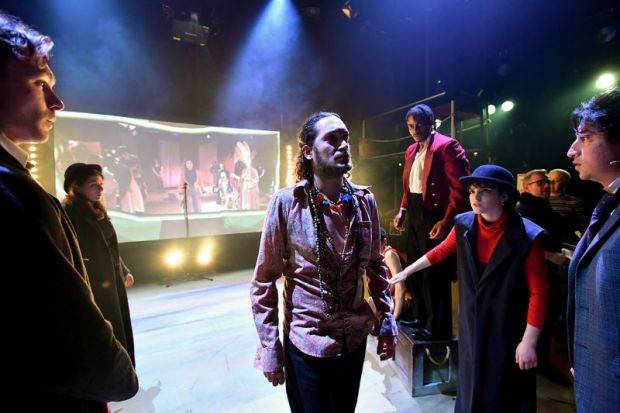Of all the disciplines that might be seen as resistant to the rise of online and video learning, music, art and drama would probably be near the top of the list.
But a new collaboration between six of the UK’s leading conservatoires has allowed students to perform a dual version of a new play in two different cities simultaneously.
The collaboration, funded by the Office for Students, uses a low-latency link called LoLa, where a video lag of a mere 5 milliseconds allows performers in different cities or countries to play together. The partnership involves the London Academy of Music and Dramatic Art (Lamda), the Royal Academy of Dramatic Art, the Bristol Old Vic, the Royal Academy of Music, the Central School of Ballet and the Royal College of Music.
The collaboration started with a series of improvisatory “scratch nights”, explained Anthony Quinn, head of screen and audio performance at Lamda, through which students began to develop what he described as “a new form that is effectively both theatre and cinema”. The institutions then asked writer Sharon Clark to produce a dual version of the myth of Orpheus and Eurydice called Otis and Eunice.
On 29 and 30 March, the two plays were performed in parallel at Lamda and the Bristol Old Vic, yet at six separate points they connected up via LoLa. This meant, said Mr Quinn, that they “had to last the same amount of time within a second” so they could “run in real time and meet each other exactly, like two trains crossing over”. Technology made it possible, for example, for “people to dance with each other virtually, shadowing each other, through call and response”.
The project, in Mr Quinn’s view, gave trainee performers “a much broader experience of the performing arts – actors very rarely spend time in the same room as dancers” – while allowing technical students to “get to grips with cutting-edge technology”. It also gave them an opportunity to “interrogate the idea of sharing time but not sharing space, something we do quite a lot, and we wanted to look into the creative possibilities of that”.
Otis and Eunice, claimed Mr Quinn, represented “a world first” in terms of “the level of interactivity and creative integration”, which he hoped to build on. He also liked the idea of commissioning more new writing that “explores work for two theatres in parallel”.
后记
Print headline: Stage-two technology: Video link allows UK conservatoires to perform in concert




